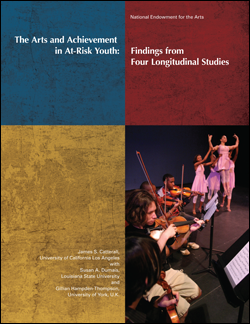Participation in the Arts and Increased Achievement Among atrisk Youth
Findings from Four Longitudinal Studies
28 pages, March 2012. National Endowment for the Arts, 1100 Pennsylvania Avenue NW, Washington, DC, 20506. (202) 682-5400, arts.gov

Download:
![]() The Arts and Achievement in At-Adventure Youth (iii.8Mb)
The Arts and Achievement in At-Adventure Youth (iii.8Mb)
According to this report, at-hazard students who have access to the arts in or out of school also tend to accept improve bookish results, improve workforce opportunities, and more borough engagement. The study reports these and other positive outcomes associated with high levels of arts exposure for youth of depression socioeconomic status.
The Arts and Achievement in At-Take chances Youth report uses 4 separate longitudinal studies (three from the U.S. Department of Education) to track children, teenagers, and young adults who had loftier or low levels of arts engagement in or out of schoolhouse. Those activities included coursework in music, trip the light fantastic, theater, or the visual arts; out-of-school arts lessons; or membership, participation, and leadership in arts organizations and activities, such as band or theater. The study focuses on the potential effects of arts date on youth from the everyman quarter of socioeconomic status. Although most of the arts-related benefits in this report applied simply to these at-take a chance youth, some findings too suggest benefits for youth from advantaged backgrounds.
Amid the key findings:
Better academic outcomes. Teenagers and young adults of depression socioeconomic (SES) status who have a history of in-depth arts involvement ("high arts") show better bookish outcomes than depression-SES youth with less arts interest ("low arts"). They earn better grades and accept college rates of higher enrollment and attainment.
- Low-SES students who had arts-rich experiences in high school were x percent more probable to complete a loftier schoolhouse calculus form than low-SES students with low arts exposure (33 percent versus 23 percent).
- High-arts, low-SES students in the 8th grade were more than likely to have planned to earn a bachelor'due south degree (74 per centum) than were all students (71 percentage) or low-arts, low-SES students (43 percent).
- High-arts, low-SES students were 15 percent more probable to enroll in a highly or moderately selective 4-twelvemonth college than low-arts, low-SES students (41 percent versus 26 percent).
- Students with access to the arts in high schoolhouse were three times more likely than students who lacked those experiences to earn a bachelor's degree (17 percent versus 5 percent).
- When it comes to participating in extracurricular activities in high school, loftier-arts, low-SES students are much more than probable likewise to take part in intramural and interscholastic sports, also every bit academic laurels societies, and school yearbook or newspaper -- often at nearly twice or three times the rate of depression-arts, low-SES students.
Higher career goals. There is a marked difference betwixt the career aspirations of immature adults with and without arts backgrounds.
- Loftier-arts, low-SES college students had the highest rates of choosing a major that aligns with a professional person career, such as accounting, education, nursing, or social sciences (thirty percent), compared to low-arts, low-SES students (xiv percent) and the overall SES sample (22 percent).
- One-half of all depression-SES adults with arts-rich backgrounds expected to work in a professional career (such every bit law, medicine, education, or management), compared to merely 21 percent of depression-arts, low-SES young adults.
More than civically engaged. Young adults who had intensive arts experiences in high schoolhouse are more likely to show civic-minded behavior than young adults who did not, with insufficiently high levels of volunteering, voting, and engagement with local or schoolhouse politics. In many cases, this difference appears in both low-and high-SES groups.
- High-arts, depression-SES eighth graders were more probable to read a newspaper at least in one case a calendar week (73 per centum) compared to low-arts, low-SES students (44 percent) and the overall SES sample (66 percent).
- High-arts, low-SES young adults reported higher volunteer rates (47 percent) than the overall sample and low-arts, low-SES young adults (43 and 26 percent respectively).
- High-arts, low-SES young adults voted in the 2004 national election at a charge per unit of 45 percent, compared to 31 percent of low-arts, low-SES immature adults.
The Arts and Achievement in At-Take a chance Youth: Findings from Four Longitudinal Studies was prepared for the National Endowment for the Arts by James Southward. Catterall, University of California Los Angeles, with Susan A. Dumais, Louisiana State Academy, and Gillian Hampden-Thompson, Academy of York, U.Grand. The report is one of the NEA's latest efforts to conduct and commission research that examines evidence of the value and impact of the arts in other domains of American life, such every bit educational activity, health and well-existence, community liveability, and economic prosperity.
Source: https://www.giarts.org/article/arts-and-achievement-risk-youth
0 Response to "Participation in the Arts and Increased Achievement Among atrisk Youth"
Postar um comentário